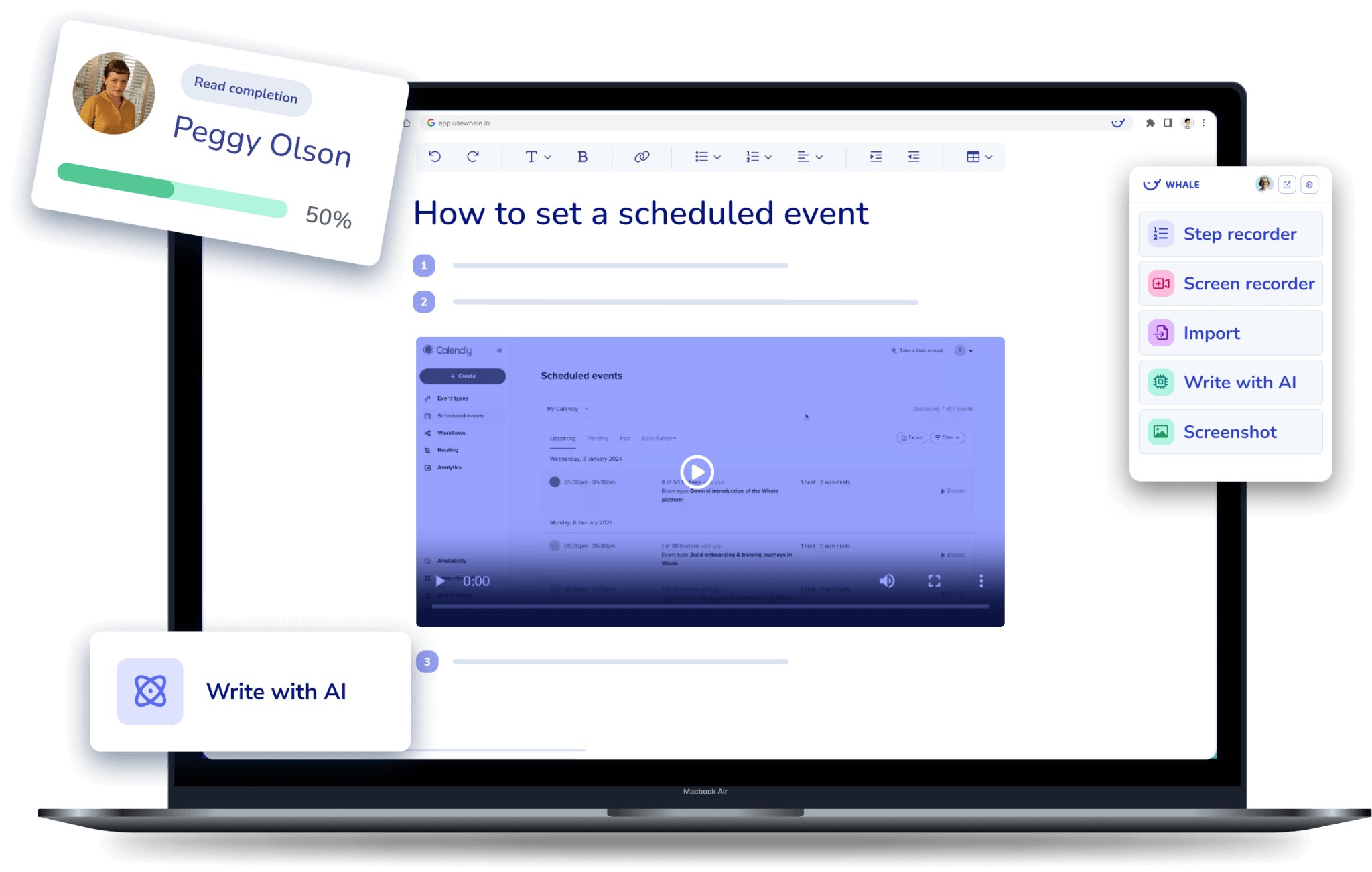Why Employee Onboarding SOPs Matter
Key Benefits of Standardized Onboarding
- Reduces new hire time-to-productivity by an average of 62%
- Improves employee retention by up to 82% according to Brandon Hall Group research
- Ensures consistent compliance with employment laws and regulations
- Creates a positive first impression that reinforces your company culture
- Reduces administrative errors in paperwork and systems access provisioning
Document SOPs for Employee Onboarding faster. Train your team better. Book a Whale demo today!
Calculate Your Savings
Universal Benefits of SOPs
- Creates accountability through clear responsibility assignment
- Ensures consistency in execution regardless of personnel changes
- Streamlines training for new HR team members
- Provides documentation for audits and compliance requirements
- Enables continuous improvement through process standardization
Core Components of an Employee Onboarding SOP
1. Pre-Arrival Preparation
- Job offer documentation and acceptance tracking
- Background check and pre-employment screening procedures
- Equipment and workspace preparation checklist
- System access requirements and provisioning
- Assignment of onboarding buddy or mentor
2. First Day Procedures
- Welcome package and company introduction
- Facilities tour and emergency procedures overview
- Required documentation completion (I-9, W-4, etc.)
- Company ID and access badge issuance
- Initial system logins and password setup
3. Orientation & Training Schedule
- Company history, mission, and values presentation
- Organizational structure and key stakeholders introduction
- Department-specific training schedule
- Role-specific training requirements
- Compliance and mandatory training assignment
4. Benefits & Administrative Enrollment
- Health insurance and benefits enrollment procedures
- Retirement plan enrollment process
- Payroll setup and direct deposit configuration
- Time tracking and PTO policy review
- Expense reporting procedures
5. Performance Expectations & Goals
- 30-60-90 day goal setting process
- Performance review schedule and expectations
- Key performance indicators introduction
- Probationary period requirements
- Regular check-in meeting schedule
Visual SOP Framework
Implementation Guide
Step-by-Step Process
1. Define Roles and Responsibilities
- Identify key stakeholders in the onboarding process
- Clearly define responsibilities for HR, IT, department managers, and mentors
- Create RACI matrix for all onboarding tasks
- Establish communication protocols between departments
- Determine escalation paths for issues
2. Create Onboarding Checklists and Templates
- Develop standardized welcome emails and offer letters
- Create department-specific orientation checklists
- Build role-specific training matrices
- Design consistent new hire paperwork packets
- Establish technology setup requirements by role
3. Build Knowledge Transfer Systems
- Document key information for new hires
- Create company glossary and acronym guide
- Develop self-service knowledge base for common questions
- Standardize department and role overviews
- Build library of training videos and resources
4. Establish Tracking and Feedback Mechanisms
- Implement onboarding task tracking system
- Create standardized check-in meeting templates
- Develop new hire feedback survey process
- Build manager feedback collection system
- Establish metrics for measuring onboarding effectiveness
5. Test and Refine the Process
- Conduct pilot with small group of new hires
- Collect feedback from all stakeholders
- Analyze task completion rates and timing
- Identify bottlenecks and friction points
- Update procedures based on findings
Common Challenges and Solutions
| Challenge | Solution |
|---|---|
| Inconsistent implementation across departments | Create centralized onboarding coordinator role |
| Information overload for new employees | Spread training over first month with priority sequencing |
| Delayed system access and equipment | Create pre-arrival checklist with 5-day lead time |
| Inadequate knowledge transfer | Implement structured mentor program with weekly checkpoints |
| Poor handoffs between HR and departments | Develop automated workflow with clear transition points |
Compliance and Regulatory Considerations
- Form I-9 Verification – Must be completed within 3 business days of start date
- IRS W-4 Requirements – Current year’s form must be used for tax withholding
- FLSA Classification – Proper documentation of exempt vs. non-exempt status
- EEO/Diversity Documentation – Voluntary self-identification options
- Industry-Specific Requirements – Such as HIPAA training for healthcare roles
Related SOPs
Frequently Asked Questions
How long should the employee onboarding process last?
While first-day procedures are critical, effective onboarding typically extends 90–100 days. The most successful programs continue structured activities through the employee’s first year, with decreasing frequency.
Who should be responsible for employee onboarding?
HR owns process design and admin, managers handle role-specific training, IT manages system access, and mentors support cultural integration. A central onboarding coordinator keeps all parts aligned.
How can we measure the effectiveness of our onboarding process?
Track time-to-productivity, new hire turnover rates (90-day & 1-year), task completion rates, new hire satisfaction, and manager readiness scores against benchmarks.
What are SOPs and why are they important?
SOPs are step-by-step process documents ensuring consistent, compliant, and efficient execution, serving as invaluable training and quality-control tools.
How can usewhale.io help with creating SOPs?
Usewhale.io offers templates, workflow automation, version control, and collaboration features to build, store, and update SOPs effortlessly.

